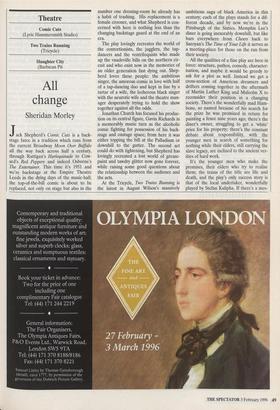Theatre
Comic Cuts (Lyric Hammersmith Studio) Two Trains Running (Tricycle) Slaughter City (Barbican Pit
All change
Sheridan Morley
Jack Shepherd's Comic Cuts is a back- stage farce in a tradition which runs from the current Broadway Moon Over Buffalo all the way back across half a century, through Rattigan's Harlequinade to Cow- ard's Red Peppers and indeed Osborne's The Entertainer. This time it's 1951 and we're backstage at the Empire Theatre Leeds in the dying days of the music-hall; the top-of-the-bill comic is about to be replaced, not only on stage but also in the number one dressing-room he already has a habit of trashing. His replacement is a female crooner, and what Shepherd is con- cerned with here is nothing less than the changing backstage guard at the end of an era.
The play lovingly recreates the world of the contortionists, the jugglers, the tap- dancers and the ventriloquists who made up the vaudeville bills on the northern cir- cuit and who exist now in the memories of an older generation fast dying out. Shep- herd loves these people: the ambitious singer, the amorous comic in love with half of a tap-dancing duo and kept in line by a tartar of a wife, the lecherous black singer with the neurotic wife and the theatre man- ager desperately trying to hold the show together against all the odds.
Jonathan Church has focused his produc- tion on its central figure, Gavin Richards in a memorably manic turn as the alcoholic comic fighting for possession of his back- stage and onstage space; from here it was either topping the bill at the Palladium or downhill to the gutter. The second act could do with tightening, but Shepherd has lovingly recreated a lost world of grease- paint and tawdry glitter now gone forever, while raising some good questions about the relationship between the audience and the acts.
At the Tricycle, Two Trains Running is the latest in August Wilson's massively ambitious saga of black America in this century; each of the plays stands for a dif- ferent decade, and by now we're in the Pittsburgh of the Sixties. Memphis Lee's diner is going inexorably downhill, but like bars everywhere from Cheers back to Saroyan's The Time of Your Life it serves as a meeting-place for those on the run from their society.
All the qualities of a fine play are here in force: structure, pathos, comedy, character- isation, and maybe it would be greedy to ask for a plot as well. Instead we get a cross-section of American dreamers and drifters coming together in the aftermath of Martin Luther King and Malcolm X to reconsider their position in a changing society. There's the wonderfully mad Ham- bone, so named because of his search for the prize he was promised in return for painting a fence nine years ago; there's the diner's owner, struggling to get a 'white' price for his property; there's the constant debate about responsibility, with the younger men in search of something for nothing while their elders, still carrying the slave legacy, are inclined to the ancient ver- ities of hard work.
It's the younger men who make the promises, their elders who try to realise them; the trains of the title are life and death, and the play's only success story is that of the local undertaker, wonderfully played by Stefan Kalipha. If there's a mes- sage here it is to do with the continuity of the human spirit up against the very limits of endurance, and in Paulette Randall's immensely strong production a cast of seven play out the random conversations that build Wilson's history of the black experience at moments of social and per- sonal crisis.
Naomi Wallace's Slaughter City (Barbi- can Pit) is a blood-spattered nightmare set in an American meat-processing plant; part fantasy and part realistic, it teems with ideas about unions and politics, wealth and poverty, workers' dignity and management corruption. There's butchery here, but not only in the slaughterhouse; Wallace is con- cerned with the cost of the American industrial dream and the nightmare it became for those caught on the wrong side of its tracks, and Ron Daniels' production brilliantly treads the borderline between myth and the reality of the meat market as it traded in humanity as well as animal flesh.



































































 Previous page
Previous page